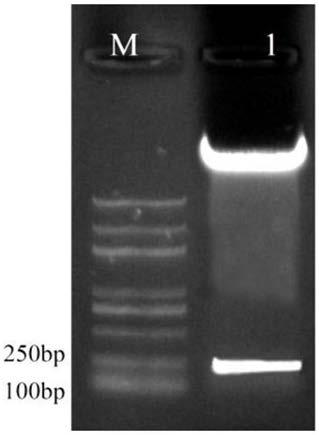Cloning and application of maize drought-resistant gene ZmDSR
A corn, gene technology, applied in the application, genetic engineering, plant genetic improvement and other directions, to achieve the effect of improving stress resistance
- Summary
- Abstract
- Description
- Claims
- Application Information
AI Technical Summary
Problems solved by technology
Method used
Image
Examples
Embodiment 1
[0033] Cloning of Example 1 ZmDSR Gene
[0034] According to the cDNA sequence of the ZmDSR gene (Gene ID: GRMZM2G122476) published by Gramene (http: / / www.gramene.org / ), use the online primer design software Primer-BLAST (https: / / www.ncbi.nlm.nih.gov / tools / primer-blast / index.cgi) design primer ZmDSR-Cloning, forward primer sequence: AGATCTTATGGCGCCGCCGGGGT, reverse primer sequence: CACGTGCTAGTAGTGGCAGCTCGTACCTAAC; then use the cDNA generated after reverse transcription of RNA extracted from material 082 as a template for amplification , the result of electrophoresis shows that the PCR product is about 250bp, such as figure 1 . The PCR product was connected to a cloning vector, and then sent to a sequencing company for sequencing. The results showed that the CDS of the gene was 234bp in length. The nucleotide sequence was shown in SEQ ID NO.1, encoding 77 amino acids as shown in SEQ ID NO.2.
Embodiment 2
[0035] Example 2 Detection of the expression level of ZmDSR under drought stress conditions
[0036] Sow the 082 seeds in the matrix until the seedlings grow to the 3-leaf stage, wash the root matrix with distilled water, and use filter paper to absorb the water in the roots; put the washed roots of the seedlings in 10% PEG-4000 hydroponic solution In the process, use an air pump to ventilate to increase the oxygen in the solution, and ventilate 3 to 4 times a day; after treatment for 0h, 1h, 6h, 12h, and 24h, samples are taken for subsequent RNA extraction and reverse transcription to generate cDNA templates.
[0037] Using the CDS sequence of the cloned ZmDSR gene, the online primer design software Primer-BLAST (https: / / www.ncbi.nlm.nih.gov / tools / primer-blast / index.cgi) was used to design quantitative primers for ZmDSR-qPCR amplification Maize seedlings were treated with PEG-4000, the forward primer sequence was: GGCGTACTTGGATTCTACGTCA, and the reverse primer: CTTTATCCTCCCGC...
Embodiment 3
[0038] Example 3 ZmDSR expression vector construction
[0039] The overexpression vector primer ZmDSR-Cloning with added BglII and PmlI restriction sites was used to amplify the ZmDSR CDS sequence, and after restriction digestion, it was connected to the binary vector pCAMBIA3301 (gifted by the National Maize Improvement Center). A fragment with a size of about 250bp was obtained, which met the expected goal, so the ZmDSR expression vector was constructed successfully, as shown in image 3 shown. ZmDSR is driven by the 35s promoter, and the pCAMBIA3301 vector has a selection marker gene bar in the T-DNA region, which encodes glufosinate acetyl CoA transferase (PAT), which can catalyze the free aminoacetylation of glufosinate, thereby Inactivates the herbicide glufosinate, see Figure 4 .
PUM
 Login to View More
Login to View More Abstract
Description
Claims
Application Information
 Login to View More
Login to View More - R&D
- Intellectual Property
- Life Sciences
- Materials
- Tech Scout
- Unparalleled Data Quality
- Higher Quality Content
- 60% Fewer Hallucinations
Browse by: Latest US Patents, China's latest patents, Technical Efficacy Thesaurus, Application Domain, Technology Topic, Popular Technical Reports.
© 2025 PatSnap. All rights reserved.Legal|Privacy policy|Modern Slavery Act Transparency Statement|Sitemap|About US| Contact US: help@patsnap.com



